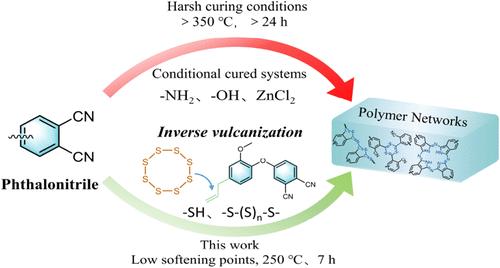Development of High-Curing-Reactivity Phthalonitrile Resins Inspired by Inverse Vulcanization
IF 5.2
1区 化学
Q1 POLYMER SCIENCE
引用次数: 0
Abstract
Phthalonitrile (PN) resins exhibit broad application prospects in aerospace and high-temperature industries due to their excellent thermal resistance and interfacial compatibility with reinforcing fibers. However, their practical use is hindered by high curing temperatures, low curing reactivity, and high melting/softening points. This study proposes a sulfur–allyl synergistic strategy inspired by inverse vulcanization, blending elemental sulfur with a biobased eugenol-functionalized PN monomer (EPN) containing allyl groups to significantly enhance curing reactivity and reduce melting/softening points and processing temperatures. Experimental results demonstrate that the EPN system with 5 mol % sulfur achieves a softening point below room temperature after prepolymerization at 180 °C. The resin cured at 275 °C exhibits a glass transition temperature (Tg) > 360 °C and a residual carbon yield >69% at 800 °C. In situ Fourier-transform infrared spectroscopy (FTIR), 2DCS, and XPS analyses reveal that elemental sulfur ring-opening mediates nitrile cross-linking, wherein inverse vulcanization generates thiol active sites and polysulfide segments to drive stepwise curing. This work provides an effective and simple approach for the optimization of the curing process of high-performance PN resins and expands pathways for the high-value utilization of sulfur resources.

以反硫化为灵感的高固化反应性邻苯二腈树脂的研制
邻苯二腈树脂具有良好的耐热性和与增强纤维的界面相容性,在航空航天和高温工业中具有广阔的应用前景。然而,它们的实际应用受到高固化温度、低固化反应性和高熔点/软化点的阻碍。本研究在反硫化的启发下,提出了硫-烯丙基协同策略,将单质硫与含有烯丙基的生物基丁香酚功能化PN单体(EPN)共混,以显著提高硫化反应性,降低熔点/软化点和加工温度。实验结果表明,含硫5 mol %的EPN体系在180℃预聚合后达到了室温以下的软化点。在275℃固化后,树脂的玻璃化转变温度(Tg)为360℃,800℃时残余碳收率为69%。原位傅里叶变换红外光谱(FTIR)、2DCS和XPS分析表明,单质硫开环介导了腈交联,其中反硫化产生硫醇活性位点和多硫段,推动了逐步固化。本研究为优化高性能PN树脂的固化工艺提供了一种简单有效的方法,为硫磺资源的高价值利用开辟了途径。
本文章由计算机程序翻译,如有差异,请以英文原文为准。
求助全文
约1分钟内获得全文
求助全文
来源期刊

Macromolecules
工程技术-高分子科学
CiteScore
9.30
自引率
16.40%
发文量
942
审稿时长
2 months
期刊介绍:
Macromolecules publishes original, fundamental, and impactful research on all aspects of polymer science. Topics of interest include synthesis (e.g., controlled polymerizations, polymerization catalysis, post polymerization modification, new monomer structures and polymer architectures, and polymerization mechanisms/kinetics analysis); phase behavior, thermodynamics, dynamic, and ordering/disordering phenomena (e.g., self-assembly, gelation, crystallization, solution/melt/solid-state characteristics); structure and properties (e.g., mechanical and rheological properties, surface/interfacial characteristics, electronic and transport properties); new state of the art characterization (e.g., spectroscopy, scattering, microscopy, rheology), simulation (e.g., Monte Carlo, molecular dynamics, multi-scale/coarse-grained modeling), and theoretical methods. Renewable/sustainable polymers, polymer networks, responsive polymers, electro-, magneto- and opto-active macromolecules, inorganic polymers, charge-transporting polymers (ion-containing, semiconducting, and conducting), nanostructured polymers, and polymer composites are also of interest. Typical papers published in Macromolecules showcase important and innovative concepts, experimental methods/observations, and theoretical/computational approaches that demonstrate a fundamental advance in the understanding of polymers.
 求助内容:
求助内容: 应助结果提醒方式:
应助结果提醒方式:


